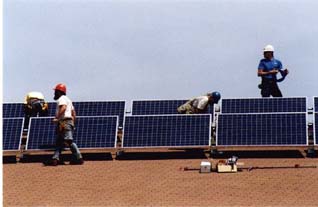Battle between CASE and CASM over Chinese PV in US rages on
 The question of whether cheap Chinese photovoltaics are imperiling the U.S. solar industry, specifically in manufacturing and whether the negative impact on domestic manufacturing outweighs the more positive effect that lowered costs have resulted in for installers rages on.
The question of whether cheap Chinese photovoltaics are imperiling the U.S. solar industry, specifically in manufacturing and whether the negative impact on domestic manufacturing outweighs the more positive effect that lowered costs have resulted in for installers rages on.
The Coalition for American Solar Manufacturing (CASM), which is supported by SolarWorld Industries America, Inc., alleged that U.S. PV manufacturing jobs are being lost because of unfair Chinese trade practices that have artificially lowered the price of Chinese silicon-based PV, and it’s gained some ground with a recent U.S. International Trade Commission finding that CASM and SolarWorld’s complaints have merit.
The Coalition for Affordable Solar Energy (CASE) contended that the solar project development industry and the silicon manufacturing industry could shed even more jobs if CASM’s complaints result in tariffs against Chinese modules and a trade war over U.S. exports of silicon and silicon manufacturing equipment to China. Case recently urged SolarWorld America President Gordon Brinser to drop the complaint.
"SolarWorld, in conjunction with…CASM, supported by over 150 associate members from 14 states employing over 11,000 U.S. workers, view today's letter as inappropriate bluster from Jigar Shah, who speaks on behalf of the Chinese manufacturers. Mr. Shah and these Chinese manufactures are well aware that their illegal trade practices are harming the U.S. economy and causing thousands of good manufacturing jobs to be lost,” Brinser said in response. “We are confident that the Commerce Department and the U.S. International Trade Commission will rule in our favor and, therefore, have no intention of withdrawing our petitions."
CASE is just as hopeful. “The previous decisions were procedural with a lower legal threshold. As we get farther into the case the legal threshold goes up so we are hopeful that the ITC will come to a conclusion that will protect the 100,000 people employed by the US Solar industry,” Shah, president of CASE, said.
One of the criticisms levied against Chinese manufacturers are significant subsidies afforded only to Chinese-based PV manufacturers. But even if they were taking significant advantage of such offerings, the companies also are facing increased competition internationally. “The solar players are acting like a normal private company without any promises of ‘free’ money from the Chinese government. The stock filings reveal that lower silicon prices and higher manufacturing efficiencies have reduced their cost of goods sold substantially. This is a universal picture, showing that the price reductions in the solar industry are sustainable—albeit painful for some manufacturers,” Shah said.
Shah also points out that the U.S. maintained a trade surplus in the PV industry with China, which could exacerbate the chance of a full-on trade war with China. The U.S. had a net trade surplus of over $300 milllion with China in 2010 that is at risk if a trade war ensues. There are many industry sectors where the US and China have differences, but solar is not one of them. Both countries need each other to meet their goals,” he said.
“In a trade war, both the US and China will lose. The US has more sunlight than any other OECD country and China is fighting to find sources of electricity to diversify away from coal. Both countries need to work together to use the economies of scale caused by Europe to roll out large solar programs,” Shah said. A trade war could hamper both country’s efforts in growing their solar industries.
image courtesy of NREL



